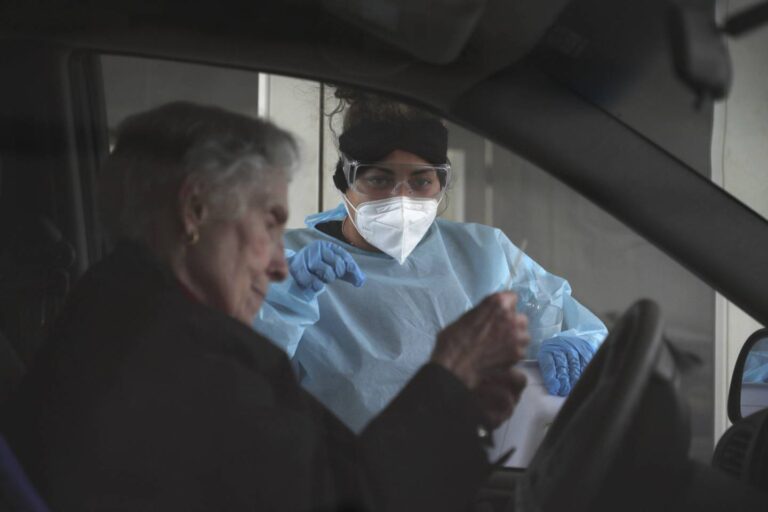Advertisement
The risk of contracting COVID-19 in suburban Cook County and other parts of the Chicago area has jumped to the “medium” level under the latest national guidelines, officials announced Friday.
As of Thursday, suburban Cook County recorded more than 200 positive cases per 100,000 residents, tipping that region into the next level of coronavirus transmission under the Centers for Disease Control and Prevention’s latest metrics. Lake and DuPage counties have also newly returned to medium risk. The statewide case rate was 193 per 100,000 residents as of Friday.
Advertisement
Chicago’s top public health official said Friday she expects the city will move to medium risk soon too.
With cases on the rise again, Chicago Public Schools also renewed its request that everyone wear masks in its buildings, though the district dropped universal masking earlier this year amid legal pressure.
As a result of its updated COVID-19 designation, the Cook County Department of Public Health is recommending — but not requiring — indoor masking, testing before social gatherings, getting booster shots and, when possible, socializing outdoors and avoiding poorly ventilated spaces.
“These recommendations are not new but are being emphasized to protect our communities from further increases in COVID,” the county’s senior medical officer Dr. Rachel Rubin said in a statement. “As hospitalizations remain low, we want to contain further spread now.”
In Chicago, Dr. Allison Arwady, commissioner of the Department of Public Health, said in a statement Friday that while the city “remains at a low COVID-19 level, with the gradual uptick in cases over the past few weeks, I expect we will cross over to ‘Medium’ soon. When we do, I view it as a yellow light of caution. We are, thankfully, very far from reaching the ‘High’ COVID-19 level, but people should begin to exercise more caution.”
The previous day, Arwady had said she was “confident that we are nowhere near needing to put vaccine requirements in place at the city level at this time because our health care system continues to do well.” She said the city will be “transparent” and recommend masks in settings where there are unvaccinated people if metrics hit the “medium” level for spread.
Earlier this month, Arwady also said CPS would reinstate its mask mandate of the city meets “medium” risk level. If the risk level jumps to “high,” then a mask requirement for most indoor public settings would return, along with a vaccine requirement for places such as restaurants and bars.
Advertisement
Chicago is currently in a “low” transmission designation, although metrics have been ticking up for weeks.
Chicago is recording an average of 151 COVID-19 cases and 2.8 hospitalizations per 100,000 residents in the past week, while 2.5% of hospital beds were occupied by COVID-19 patients.
In suburban Cook County, there have been an average 214 cases and 4.8 hospital admissions per 100,000 residents in the past week, while 3.1% of hospital beds were occupied by COVID-19 patients.
Statewide, health officials on Friday announced 5,955 new confirmed and probable cases of COVID-19, the most in a single day since Feb. 4, when the massive winter surge driven by the highly contagious omicron variant was subsiding.
Advertisement
Over the past week, the state has averaged 3,521 cases per day, up from 2,793 daily cases the previous week. The average number of cases had dipped as low as 1,067 per day during the week ending March 18 before beginning to slowly rise once again.
Hospitalization numbers also are rising but at a more gradual pace than earlier in the pandemic.
There were 732 patients with COVID-19 in Illinois hospitals as of Thursday night, up from 613 a week earlier. After reaching an record of 7,380 during the height of the omicron surge in January, the number of patients in the hospital dropped to 434 statewide by April 2.
Gov. J.B. Pritzker, who lifted his statewide mask mandate Feb. 28 and lifted the mandate for public transit last week, said he’s carefully watching the rise in cases.
“I don’t like to see cases going up,” Pritzker said Friday at an unrelated event in Chicago. “But I will say that this stealth omicron, which is the variant that we’re in right now, does not seem to be sending, percentage-wise, the number of people to the hospital that its predecessor did. That’s good. We don’t like to see anybody go to the hospital though. … The most important thing is keeping our health care system available.”
Pritzker said he recently got his second booster dose of the COVID-19 vaccine and encouraged others who are eligible to do the same or to begin getting vaccinated if they haven’t already.
Advertisement
The CDC’s latest metrics for assessing a community’s COVID-19 risk look at a mix of numbers for caseloads, hospital admissions and occupied inpatient beds. Regions with more than 200 cases per 100,000 residents in the past week are automatically considered “medium” risk or higher.
Tribune reporter Tracy Swartz contributed.







